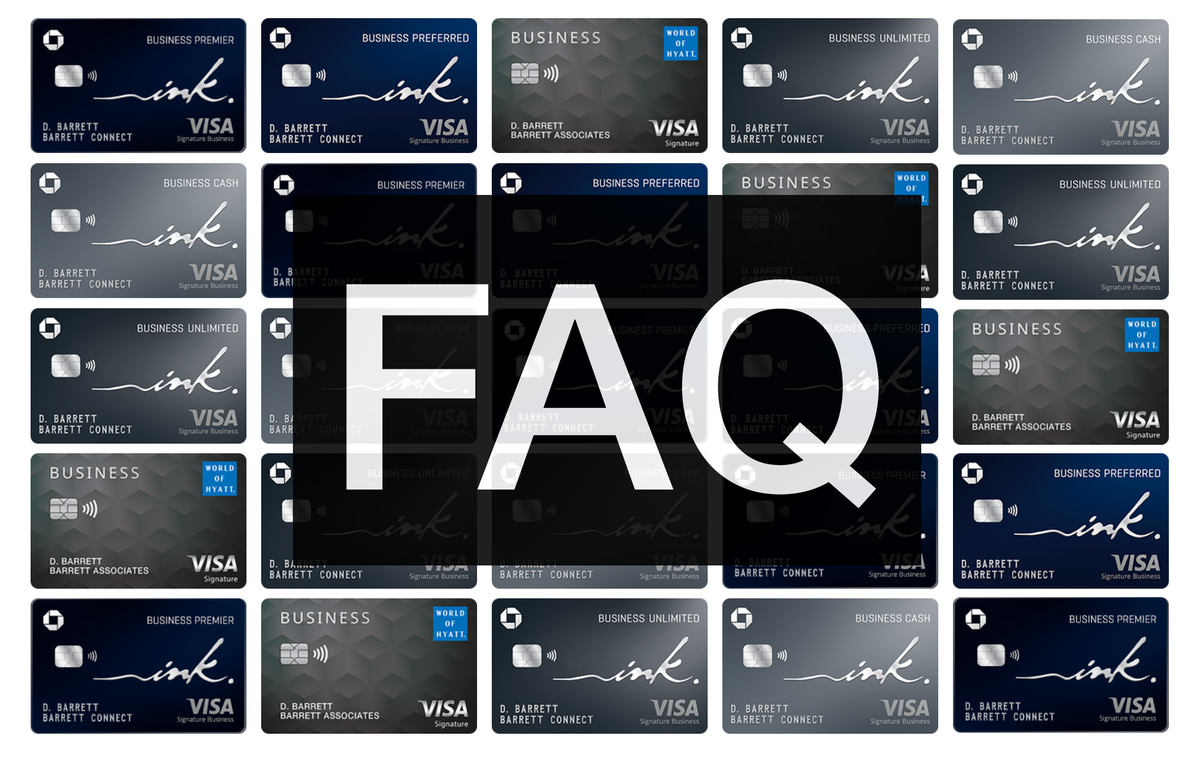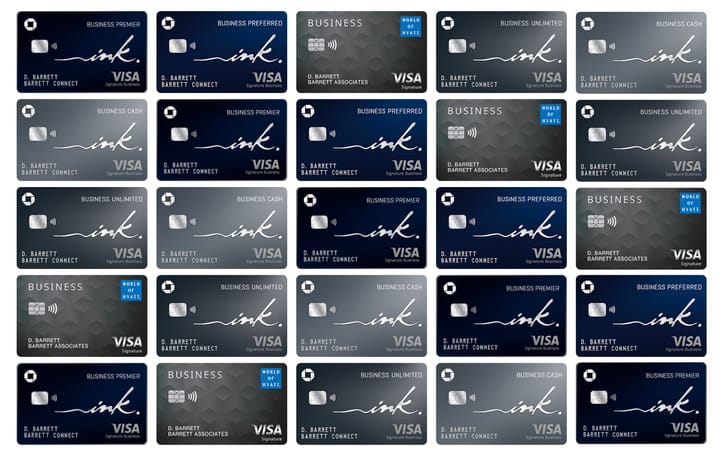Chase Ink Business Card Applications: In-Depth FAQ Guide for Multiple Cards, Bonus Rules, and Credit Strategies
Advanced application and approval techniques in the most comprehensive FAQ guide available.

This guide covers the most frequently asked questions when applying for multiple Chase Ink Business cards. We break down application steps, how to boost your approval odds, and how to use an EIN/SSN strategy to secure multiple Ink cards.
Application Process and Eligibility
Questions about whether individuals can apply for multiple Chase Ink cards using just their SSN, or a combination of SSN and EIN, and the potential impact on approval. How applying for business cards affects personal credit scores and queries about Chase's 5/24 rule.

Can I apply for another of the same Chase Ink card using only my SSN if I already have one?
Yes, you can apply for another of the same Chase Ink card using just your SSN. Just be sure to close or product-change your existing card before applying for the same card. It’s challenging to justify the need for duplicate cards for the same business, and I recommend avoiding the scrutiny that might come from Chase’s reconsideration department as much as possible. By adopting this cyclical approach, I’ve obtained 3 Chase Ink Preferred cards in the past 3 years.
In what order should I apply for the Ink card using SSN or SSN+EIN?
Start with SSN and sole proprietorship for your first series of Ink cards. Then apply for a second series using SSN+EIN as a sole proprietorship. A series refers to all 4 cards in Chase’s Ink portfolio (Ink Preferred, Ink Cash, Ink Unlimited, and Ink Premier). You do not have to apply for the cards sequentially, you can alternate between SSN-only and SSN+EIN applications. For example:
- CIP (SSN)
- CIP (EIN+SSN)
- CIU (SSN)
- CIC (SSN)
- CIU (EIN+SSN)
- And so fourth.
How often can I apply for these Chase Biz cards and not get denied by Chase?
Generally, apply for no more than 2 Chase cards every 2-3 months, steering clear of their 2/30 rule. It's preferable to wait 3 months between applications. This strategy helps to maintain a healthy credit profile and minimize the risk of being perceived as credit-hungry, which can lead to denials or the dreaded Chase financial review.
Can I get multiple of the same Chase Ink card?
Yes, you can get multiple of the same Chase Ink card by applying with either your SSN alone, or using a SSN+EIN.
How does applying for Chase business cards affect my personal credit score?
Applying for Chase business cards can result in a temporary dip in your score due to hard inquiries but generally won't affect your personal credit utilization. While the initial application may impact your score, business card activities typically don't report to personal credit bureaus, thereby minimizing long-term effects to your credit score.
What is the Chase 2/30 rule?
The Chase 2/30 rule states that you can be approved for at most two Chase cards within 30 days. This rule helps manage the number of new accounts and ensures that customers don't take on too much credit too quickly, which can be risky for both Chase and the customer.
What is the Chase 5/24 rule?
The Chase 5/24 rule states that if you've opened 5 or more credit cards across all banks in the past 24 months, you're unlikely to be approved for a new Chase card. This rule is a crucial consideration for anyone planning their credit applications — it significantly impacts your Chase card approval rate.
Bonus Eligibility and Referrals
Questions about the possibility and implications of referring oneself for another card to gain bonus points, and regarding eligibility for new cardmember bonuses, especially related to the legacy 24-month rule for existing/previous cardholders
What is the Chase 24-month bonus eligibility rule for existing cardholders seeking new applications?
This is no longer applicable, it’s a legacy rule prior to 2021. The old T&Cs used to state: “The new Cardmember bonus offer is only available if you do not have this card and have not received a new Cardmember bonus for this card in the past 24 months.”
The current rule states: “Chase cardmembers who currently have or have had a Chase credit card in any Rewards Program associated with this offer, may not be eligible for a second Chase credit card in the same Rewards Program.”. However, based on my personal and anecdotal experience, this hasn’t been enforced — you can get multiple sign up bonuses even for the same card!
Can I get bonuses on multiple Chase Ink cards?
Yes, bonuses can be obtained on multiple Chase Ink cards. This applies whether you apply for multiple of the same card using just your SSN, or if you apply using EIN+SSN. Each newly opened account is eligible for its own set of bonuses.
How do referral bonuses work with multiple applications?
You can refer the same person for multiple cards, and they can refer you back as well. Avoid self-referrals — it’s not worth it, and might flag your account. Engaging in a mutual referral with a trusted P2 partner or colleague can be a strategic way to boost bonus points for both parties.
Is it possible to self-refer for another card and get a bonus?
No. It was possible to self-refer for another card in the past (pre-2019), but Chase has cracked down on this practice. While it can be tempting, it's now considered an extremely risky move that might lead to account reviews or closures. A workaround is to find a trusted friend or partner to create a virtuous referral cycle.
Specific Card Questions (CIP, CIU, CIC)
Can I apply for the same card (like Chase Ink Preferred) again using EIN+SSN?
Yes, you can apply for the same card like Chase Ink Preferred again using EIN+SSN and still be eligible for the bonus — it’ll be considered a separate account.
How does applying for different Ink cards (CIP, CIU, CIC) work?
You can apply for different Ink cards using the same approach of SSN for the first card and then EIN+SSN for additional cards. (See Application Process and Eligibility)
Strategy and Timing
Questions on the optimal timing for new applications, how often one can safely apply without triggering denials.

When should I apply for a second card after the first one?
Wait about 2-3 months between applications for safety and to avoid raising flags with Chase. Although Chase has 2/30 rule in place, where you can get approved for up to 2 cards in 30 days, I recommend being more conservative with your Ink applications. Be patient. Play the long game. Don’t go too fast, or you might crash and burn!
What strategy should I use for applying with EIN and SSN?
Use your SSN for the first card application, then apply for additional cards with EIN+SSN. This strategy maximizes your chances of approval and bonus eligibility by treating each application as a separate entity..
How many Chase Ink cards can I apply with one EIN?
There's no strict limit, but generally, you can apply for multiple cards using one EIN as long as your credit and business justifications are solid.
Can a sole proprietorship have multiple EINs?
A sole proprietorship cannot have multiple EINs because the business and owner are legally the same. However, if you have multiple incorporated businesses (LLCs or corporations), each can have its own EIN, opening the door to multiple bonuses for the same card.
How does the timing of applications affect approval and bonuses?
Applying too quickly and too frequently can raise red flags. Space out applications to every 2-3 months for the best chance of approval and bonuses. This pacing demonstrates responsible credit management and can lead to more favorable decisions from Chase.
Can I get multiple Chase Ink Cards at once?
It's not recommended to apply for multiple Chase Ink cards simultaneously. Space out your applications for a better approval rate. Applying for several cards at once can signal to Chase that you're a high-risk borrower needing a lot of credit in a short period of time, potentially leading to denials.
Credit Limit and Card Management
Concerns about managing multiple cards, shifting credit limits, and the implications of having several cards open.

How does the credit limit work with multiple cards?
You can shift credit limits between business cards by contacting customer service. However, you cannot shift credit limits between business and personal Chase cards.
Should I cancel my first card when I get a second one?
Instead of canceling, consider downgrading the first card to a no-fee option like Ink Cash to maintain good standing with Chase before cancelling it the next year. You’d want to avoid a predictable pattern of constantly closing Ink cards after a year of having them because it might draw scrutiny from Chase.
How can I reallocate credit limits across my Chase business cards?
To reallocate credit limits across Chase business cards, contact Chase customer service or send a secure message through your online account. Shifting credit from existing cards to a newly opened one, like the Ink Unlimited or Ink Cash with 0% APR offers, allows you to maximize your spending power on the new card while enjoying the introductory interest rate. However, always ensure that you maintain a balance that you can responsibly manage and pay off to avoid future financial strain.
Business Proof and Documentation
Queries about the type of documentation needed for business cards and what Chase requires for proof of business.

What kind of documentation is needed for business cards?
Typically, documentation for a sole proprietorship may include Proof of Business Name and Proof of Business Address.
- Proof of Business Address: a utility bill showing your name.
- Proof of Business Name: the IRS EIN confirmation letter would suffice. Although you can also provide Articles of Incorporation, Certificate of Formation, or the Fictitious Business Name (DBA) Statement.
Do I need to provide proof of business for EIN applications?
For EIN applications, the IRS EIN/TIN confirmation letter would be sufficient as proof of business.
How do I register for an EIN?
Register for an EIN through the IRS website. It's a straightforward process requiring basic business information such as the name, address, and type of business. Don’t forget to save the confirmation letter as Proof of Business Name.
How does Chase verify the existence of my business?
Chase might ask for documents like utility bills or official state filings to verify the existence of your business, especially if the business name differs from your name. It’s always a good practice to retain a copy of your EIN confirmation letter.



Comments ()